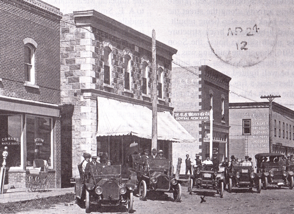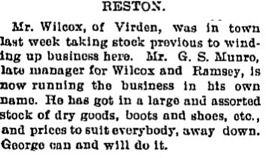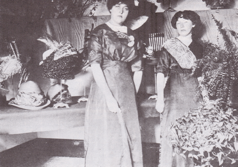The longest established general store in Reston was
known for seventy-two years as G. S. Munro Co. Ltd.

In the spring of 1893, Mr. Wilcox, a pioneer merchant of Virden
established a branch store in the new village of Reston and put a young
man named G. S. Munro in charge. Mr. Munro liked Reston and in 1894 he
married Kate Campbell and settled in to become one of Reston's leading
citizens. Mr. Munro managed the business for some time and then bought
out Mr. Wilcox.

Brandon Sun, March 10, 1896
Mr. Monroe kept Shetland ponies on his Sinclair area farm. He and Kate
we very involved in community affairs. He was superintendent of the
Sunday School for years and sang bass in the choir all his life here.
He built the present stone building in 1902 and built up a large
business and drew patronage from many miles around.
Munro's was very versatile and brought in the best services for
customers. In 1921, Mr. J. Sibbald had graduated as a practipedist and
was looking after fitting shoes. They catered to the ladies with
a special millinery section on the second floor and there were official
spring and fall openings yearly.
Adapted from Trails Along the Pipestone, page
489, 493, 591
A Day in the Life of a General Store
The small-town general store, also known as mercantiles and emporiums,
were essential aspect of commercial activity in small-town life, and
saw their heyday in the period between 1880 and 1930.
These establishments served the rural populations of small towns and
villages and the farmers in the surrounding area. Besides selling dry
goods, farming equipment and other supplies, they sometimes also served
as the local post office, drugstore and undertaker. They were also a
popular meeting place for socializing and news gathering.
The storekeepers stocked their establishments with merchandise procured
from salesmen who represented wholesale houses and manufacturers found
in larger cities. Merchandise selections were often large and varied,
though most of the items available for sale were those of necessity. As
people and businesses prospered in the economy during the 1890s more
luxury items were introduced into the store inventories. The expansion
of the railroads, the advent of mass production and technological
advances such as the refrigerated railcar to transport perishable foods
all combined to escalate the national distribution and variety of goods
that were available in the stores.
Most of the wall space in a general store was taken up with shelving to
store and display for the merchandise; likewise the floors were crowded
with barrels, wooden boxes and crates. Store counters were good for
holding display cases for the smaller items, a coffee grinder, scales
and a cash register. Many stores had a display window or two in the
front of the building. Cellars, basements and second floors were used
for storage of merchandise and displays.
The proprietors of general stores knew almost all of their customers
and they were adept at anticipating their needs. It was not uncommon
for articles to be sold on credit or for payment to be accepted in the
form of bartered goods.
What were some of the items that could be found in a general store?
Food and consumables included coffee beans, spices, baking powder,
oatmeal, flour, sugar, tropical fruit, hard candy, eggs, milk, butter,
fruit and vegetables, honey and molasses, crackers, cheese, syrup and
dried beans, cigars and tobacco.

Larger General Stores, such as the G.S. Monroe
Store in Reston, featured a well-stocked millinery department.
Dry goods included bolts of cloth, pins and needles, thread, ribbon,
silk, buttons, collars, undergarments, suspenders, dungarees, hats and
shoes.
Essential items such as rifles, pistols, ammunition, lanterns, lamps,
rope, crockery, pots and pans, cooking utensils and dishes, farm and
milking equipment and even coffins could be found.
The apothecary sections of the stores were well represented with a
surprisingly large number of patent medicines, remedies, soaps and
toiletries and elixirs.
|





